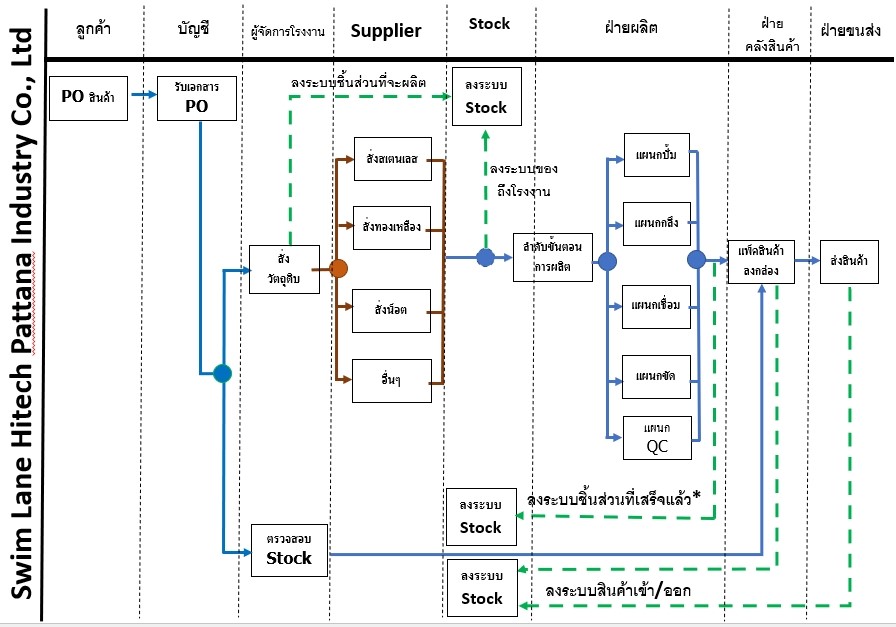Design and Implementation of Industrial Logistics Communication System with Google Workspace : A Case Study Hitech Pattana Industry Co., Ltd
Keywords:
Swim Lane Diagram, Google Workspace, Manufacturing LogisticsAbstract
This research designed and developed a communication system for logistics production using Google Workspace, to be used for communication of logistics data in production departments. The system aimed to gather data on the status of products, both in terms of quantity and quality, by collecting data on the flow process of products using Swim Lane diagrams and recording data through Google Forms. The system is designed to allow workers to enter data through Google Forms for recording data in Google Sheets, and to use the system. Evaluation of its satisfaction levels came from two user groups: A group providing information consisting of 11 people, and a group using the information consisting of four people. The results showed that the group providing information had the highest level of satisfaction in overall satisfaction (Mean±S.D. = 4.40±0.54), ease of use (Mean±S.D. = 4.55±0.57), and system performance (Mean±S.D. = 4.21±0.50). The group using the information had the highest level of satisfaction in overall satisfaction (Mean±S.D. = 4.38±0.39), ease of use (Mean±S.D. = 4.58±0.55), system performance (Mean±S.D. = 4.13±0.19), and the level of benefits obtained from the system (Mean±S.D. = 4.75±0.50). Therefore, an online logistics communication system can support the logistics process of the production department of the company.
References
Azevedo SG, Ferreira J, Leitao J. The role of logistics information and communication technologies in promoting competitive advantages of the firm [Internet]. 2019 [cited 2022 August 25]. Available from:http://mpra. ub.uni-muenchen.de/1359 /
สกาวรัตน์ โบไธสง. ระบบสารสนเทศ [อินเตอร์เน็ต]. 2565 [เข้าถึงเมื่อวันที่ 25 สิงหาคม 2565] เข้าถึงได้จาก https://docs. google.com/presentation/d/1SnNX6a473EFMXnMJfSjEDFKaSF5bVxC 8oCxgXFZtSN0 /edit#slide=id.p.
บัณฑิต ศรีสวัสดิ์. เทคโนโลยีสารสนเทศกับโลจิสติกส์. รายงานสืบเนื่องการประชุมวิชาการระดับชาติ ครั้งที่ 4 สถาบันวิจัยมหาวิทยาลัยราชภัฎกำแพงพชร [อินเตอร์เน็ต]. 2560 [เข้าถึงเมื่อวันที่ 25 สิงหาคม 2565] เข้าถึงได้จาก https://research.kpru.ac.th/sac/fileconference/11352018-05-01.pdf.
อัมพวรรณ หนูพระอินทร์ และ ธีราวรรณ จันทร์แสง. โลจิสติกส์กับการพัฒนา อุตสาหกรรมไทยยุค 4.0. วารสารการจัดการมหาวิทยาลัย วลัยลักษณ์ 2563;9(1):119-29.
Wu D, Greer MJ, Rosen DW, Schaefer D. Cloud manufacturing: Strategic vision and the State-of-the-art. Journal of Manufacturing System 2013;32(4): 1-16.
Liu Y, Wang L, and Wang XV. Cloud Manufacturing: Latest advancement and future trend. Procedia Manufacturing 2022;25:62-73.
Niharika G, Ritu DV.Cloud architecture for the logistics business. International Symposium on Big Data and Cloud Computing. Procedia Computer Science 2015; 50:414-20.
Yang M, Mahmood M, Zhou X, Shafaq S. Design and Implementation of Cloud Platform for Intelligent Logistics in Trend of Intellectualization. China Communication 2017; 14(10):180-91.
STREET SMART. Google Workspace คืออะไร. [อินเตอร์เน็ต] [เข้าถึงเมื่อ 2565 สิงหาคม 25].เข้าถึงได้จาก https: //street-smart.co.th/th/ what-is-g-suite/
โอฬาร เชี่ยวชาญ และ อนุกิจ เสาร์แก้ว. การ บูรณาการประยุกต์ใช้ RFID (Radio Frequency I dentification) และ iOT (Internet of Thing) ผ่านระบบคลาวด์ (Cloud Computing) สำหรับการจัดการโลจิสติกส์.วารสารวิชาการคณะเทคโนโลยีอุตสาหกรรม มหาวิทยาลัยราชภัฎลำปาง 2560;10(2):109-19.
ลัดดาวัลย์ เพชรโรจน์ และ อัจฉรา ชานิประศาสน์.ระเบียบวิธีการวิจัย. กรุงเทพฯ: พิมพ์ดีการพิมพ์. 2547.
สุมิตรา ศรีชูชาติ. สถิติธุรกิจ. เชียงใหม่: มหาวิทยาลัยราชภัฏเชียงใหม่; 2550.
พาขวัญ ชูอำไพ และ ชลิตา ศรีนวล. การวิเคราะห์ความพึงพอใจของผู้ใช้งานระบบบัญชีสามมิติ ในสถาบัน เทคโนโลยีพระจอมเกล้าเจ้าคุณทหารลาดกระบัง. วารสารวิทยาการจัดการ 2560; 4(20):143-73.
Chen SL, Chen EYY. Design and implementation of a global logistic tracking system based on SaaS cloud computing infrastructure. Journal of System and Management Sciences 2011;1(1):85-96.
Riste T. Cloud computing in logistic and supply chain management environment. Journal of Economic 2021;6(1):23-32.
Wang X, Li W, Zhong Y. Research on cloud logistics–based one–stop-service platform for logistics center. International Conference on Computer Supported Cooperative Work in Design [Internet] 2012 [cited 2022 Aug. 15]; 1:558-63. Available from: https://ieeexplore. ieee.org/stamp/stamp.jsp?tp=&arnumber=6221873.
Sergi I, Montanaro T, Benvenuto FL, Patrono L. A Smart and Secure Logistics System Based on IoT and Cloud Technologies. Sensor 2021;21(6):1-23.
Feng B, Qiwen YE. Operations management of smart logistics: A literature review and future research. Front Eng. Manag 2021; 8(3):344-55.
Animesh T, Megha J. Analysis of supply chain management in cloud computing international. Journal of Innovative Technology and Exploring Engineering 2013;3(5):152-55.

Downloads
Published
Issue
Section
License
บทความทุกบทความที่ตีพิมพ์ในวารสารการพัฒนางานประจำสู่งานวิจัย (JPR2R) ถือว่าเป็นลิขสิทธิ์ของวารสารการพัฒนางานประจำสู่งานวิจัย คณะสิ่งแวดล้อมและทรัพยากรศาสตร์ มหาวิทยาลัยมหิดล





